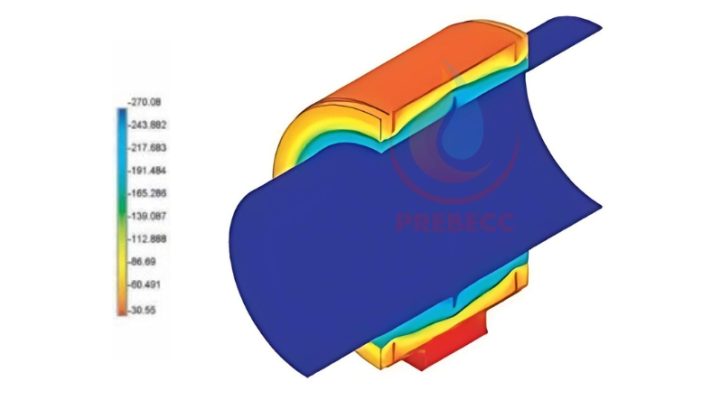The project to expand the energy supply piping system at the Bien Hoa food and beverage plant in Dong Nai marks a significant step in the sustainable development journey of a leading industry group. Officially receiving the design request on July 8, 2024, and completing it on July 13, 2024, this project is expected to bring many important benefits to stethe production process.
1. Technical Specifications of the Piping System
The plant’s expanded piping system is designed and fabricated according to ASME B31.3 – the leading international standard for the design and construction of industrial piping systems.
- Design Pressure: 1.85 MPa
- Design Temperature: 116.6°C
- Hydrostatic Test Pressure: 2.31 MPa
- Pipe Size: from Φ21 mm (DN15) to Φ273 mm (DN250)
- Pipe Material: Seamless steel pipe SA-106 Gr.B – ASME specification
- Insulation: Rockwool pipe insulation with a density of 120 kg/m³, 50mm thickness
- Outer Cladding: Stainless steel, color-coated steel, aluminum sheets
- Valves and Fittings: Pressure gauges, control valves, globe valves, ball valves, butterfly valves, check valves, strainers, steam traps, expansion joints, etc.
- Welding Technology: TIG welding, MIG welding, stick welding, gas welding
- Welding Standards: Compliant with TCVN 6008:2010, AWS (radiographic, ultrasonic, hydrostatic tests, weld tests)
- Equipment Connected to the Piping: Steam headers, water tanks, condensate tanks
- Accessories: Pipe supports, hangers, sliding supports, pipe clamps, flanges, elbows, tees, reducers, gaskets, bolts, etc.
- Application of the Piping System: Used for conveying steam for production purposes
2. Prebecc’s Solution
The food and beverage plant of the Swiss corporation is undergoing a transformation towards achieving a 50% regenerative food system by 2030. To reach this goal, the upgrade and expansion of the plant’s energy supply piping system is essential. The old system no longer meets the requirements for steam load, pressure, and temperature in the production of new food and beverage products while also needing to ensure higher stability and efficiency. This presents a significant challenge for the plant.
PREBECC has provided a comprehensive solution to address this issue.
2.1. Materials for Steam Pipes
For high-temperature applications, steam pipes are supplemented with elements such as Cr and Mo to improve strength and high-temperature resistance. The steam piping system includes pipes, valves, and equipment rated for the maximum allowable working pressure of the boiler according to ASME standards.

2.2. Thermal Expansion Calculations
When the steam distribution piping system transitions from a cold state to a hot state and vice versa, thermal expansion occurs. Calculating the thermal expansion of the piping system, installing expansion joints, and appropriately arranging mobile and fixed supports and hangers is crucial in system design.
Failure to address this can lead to stresses on the pipes, resulting in misalignment, cracking, system failure, economic losses, and operational safety risks.
Given the pressure and temperature conditions, our team of engineers has calculated the thermal expansion of the piping to ensure the system’s safety and efficiency.

2.3. Insulation for piping and hot surfaces
Uninsulated pipes and hot surfaces can result in heat loss of approximately 3 btu/ft 2 – ΔF/hr.
To mitigate this loss, equipment must be adequately insulated, especially around steam pipes. Insulating with Rockwool helps minimize heat loss, ensuring that the temperature during production remains stable and optimal.
Our engineering team calculates heat loss using analysis software to achieve the best results (thickness, density, cost reduction, etc.). As a result, the final product is of higher quality, meeting the stringent standards of the market and consumers.

2.4. Blowdown Heat Recovery
Recover blowdown heat if you have a continuous surface blowdown rate exceeding 5% of the steam flow rate. Blowdown water leaving the boiler will have the same temperature and pressure as the water inside the boiler. Before this high-energy blowdown water is discharged, its heat can be recovered using flash tanks, heat exchangers, or a combination of both.

3. Sustainable Development with the New Piping System
This solution ensures that the system will operate stably and safely in harsh production environments.
The expanded piping system project at the food and beverage plant in Bien Hoa, Dong Nai is a significant step in the plant’s sustainable development journey. Being part of a leading Swiss F&B Group, the application of strict standards and technologies in production is imperative. The initial proposal and redesign phase is crucial to the entire project, including procurement, construction, and installation. Therefore, Prebecc is proud to have been entrusted by the customer as the design solution partner for this important project.
With PREBECC’s comprehensive solution, the new piping system not only meets stringent technical requirements but also brings numerous important benefits to the production and business processes. We are proud to be a trusted partner, accompanying our customers on the path of development and innovation:
- Reliability: We are committed to reliability in providing steam piping services and meeting the scheduled timeline.
- Time and Cost Efficiency: The optimized steam piping system helps save time and reduce operating costs.
- Continuous Technical Support: We provide continuous technical support and maintenance services to ensure the system always operates stably.
